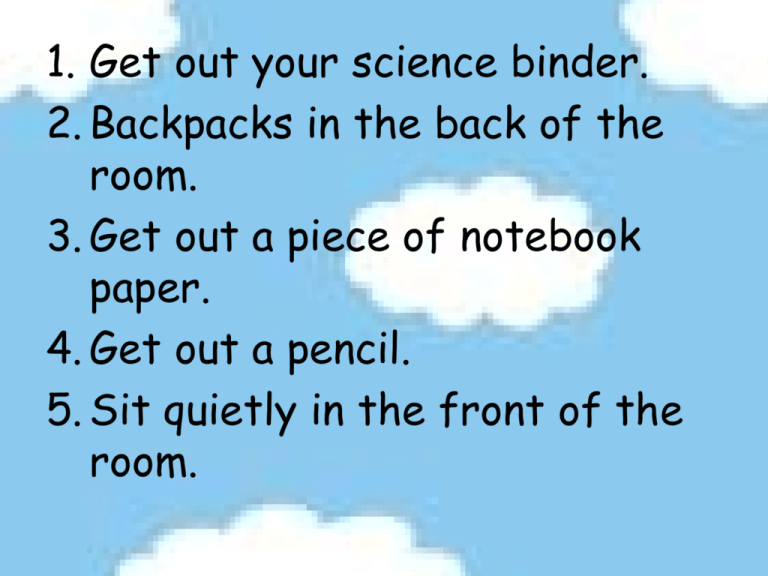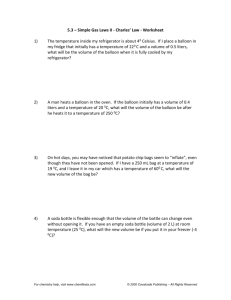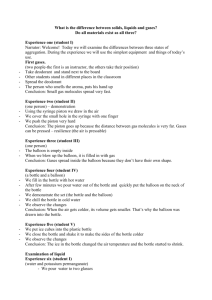Air and water
advertisement

1. Get out your science binder. 2. Backpacks in the back of the room. 3. Get out a piece of notebook paper. 4. Get out a pencil. 5. Sit quietly in the front of the room. Demonstrations Directions • As we go through each demonstration, your job is to observe quietly. • You will need to take notes after each demonstration – words & pictures. • These notes will be handed in for a grade. • Title a piece of notebook paper Air & Water Demos Air & Water • Air and water share many of the same characteristics • Air and water “act” in the same way – especially when hot or cold. • Air contains moisture (water) • Understanding the properties of air and water is important to understanding weather. #1:The Water Cycle • evaporation (Steam rising), • condensation (water collecting on bottom of pan), • precipitation (drops of water falling from pan). Draw a picture of the lab Investigating Air • Air is all around us but is difficult to investigate because you cannot see, taste, or touch it. #2: Heavy Air? Which has more weight – a balloon filled with air or an empty balloon? Directions 1. 2. 3. 4. 5. Weigh an empty balloon on a scale Record the weight Fill the balloon with air Weigh the balloon again Find the difference between the weight with air and without air. Directions 1. Fill 2 balloons with air. 2. Tie a string to each end of the balloon and attach to a meter stick. 3. Balance the scale. 4. Put a hole in 1 balloon and let the air out of the balloon. 5. Observe what happens to the meter stick. What did we learn? #2: Air has weight; the balloon with air weighs more than without air Draw a picture of one of the labs. Air has weight • Even though air seems light, it has weight • The air inside a bus weighs as much as one of the passengers • Even though we cannot feel it, there is about 14 pounds of air pressing down on every square inch of our skin • Air pressure is a powerful force that is caused by a layer of air called the atmosphere which surrounds the earth. • Air pressure is measured with an instrument called a barometer. #3: Hot Air 1. Attach 2 paper bags upside down at the end of each scale. 2. Using a lighter, heat the air under one bag. 3. Observe. 4. Take the lighter away from under the bag 5. Observe Heating & Cooling Molecules • All materials are made of tiny particles called molecules. • Molecules are always moving. • This movement creates heat. • The amount of heat depends on how fast the molecules move. • As the molecules move faster, they take up more space and make the object expand. • High temperature = Faster molecules • Low temperature = slower molecules • Animation • Really crazy animation (molecules in motion) What did we learn? #3: Hot air rises & is lighter than cooler air. The molecules spread out & weigh less so the bag rises. Draw a picture of the lab. #4: A Balloon Full of…? 1. Tie a balloon over an empty bottle 2. Place the bottle in hot water 3. Observe what happens to the shape of the balloon What did we learn? #4: Hot air expands; the balloon inflated when the air in the bottle heated up. Draw a picture of the lab #5: Can you Handle the Air Pressure? What happens to the air inside a container when heated or cooled? Eggtastic! 1. Put the empty bottle on a table. 2. Peel the boiled egg. 3. Light a match and drop it into the bottle. Repeat about three or four times. 4. Quickly put the egg over the mouth of the bottle. What happened? • The lit match heats the air inside the bottle. • When air is heated it expands and takes up more room. • As the heated air expands, some of it escapes out of the bottle. • When the matches go out, the air inside the bottle cools and contracts, which takes up less room. • This creates a lower pressure inside the bottle than outside the bottle. • The greater pressure outside the bottle forces the egg to get sucked into the bottle. When you add the match the air heats up and expands When the match goes out the air shrinks reducing the pressure inside the bottle Crush that Can! 1. Place an empty metal can on a heat source 2. Cover the can and remove from heat. 3. Observe What did we learn? #5:Hot air expands & takes up more space than cold air - metal can collapses; cold air condenses & takes up less space- egg sucked into bottle (partial vacuum) Draw a picture of the lab #6: Swirls of Water 1. 2. 3. 4. 5. Heat up a cup of water until it is hot Color the hot water red with food coloring. Cool off water with ice. Color the ice water blue with food coloring. Have a bowl or bin of room temperature water. 6. Add the hot water one at one end of the bowl and the cold water at the other end of the bowl. 7. Observe the water. Density • Hot – – – – Less molecules Lower density Lighter Rises • Cool – – – – More molecules Higher density Heavier Sinks Currents What did we learn? #6: Hot water rises & moves to the top; cold water sinks & moves to the bottom. (currents) Draw a picture of the lab. “Air”-y Facts 1. Cold air sinks because it is denser than warm air. 2. Warm air is less dense than cold air. 3. Warm air can hold more moisture than cold air. 4. When air cools, it loses some of its moisture. 5. Warm air rises, losing moisture as it cools. 6. Cold air sinks and pushes up warm air. Air & Water Demonstrations 1. Water Cycle: evaporation (Steam rising), condensation (water collecting on bottom of pan), precipitation (drops of water falling from pan). 2. Heavy Air : ball or balloon filled with air weighs more. 3. Hot Air : Warmer air is lighter (less molecules; molecules spread out) than cooler air; bag rises. 4. Balloon Full of… : hot air expands and takes up more space; balloon inflated when air in bottle heated up. 5. Eggtastic!: Cold air condenses,, & takes up less space than hot air; egg in bottle. (partial vacuum) 5. Crush that Can! :Hot air expands & takes up more space than cold air; metal can collapses. 6. Swirls of Water : Hot water rises and moves to the top; cold water sinks and moves to the bottom. (Currents) Really crazy animation (molecules in motion)





